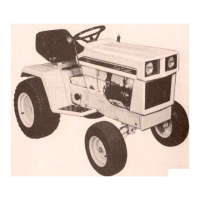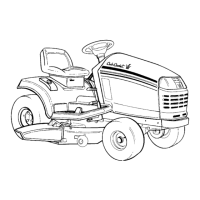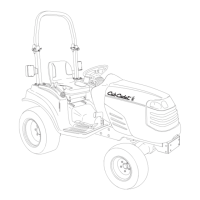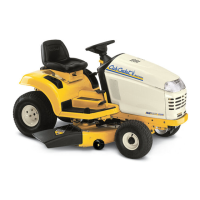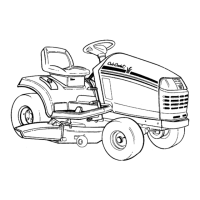HYDRO. DRIVE AND BRAKE SYSTEM
30
3. Check the hydro. by-pass linkage:
See Figure 5.2.
3a. If the tractor does not drive with as much
speed or power as normal:
• Confirm that the Transmission Release Rod is
fully engaged (pushed-in).
• When the Transmission Release Rod is fully
engaged, confirm that the by-pass arm on the
side of the transaxle moves freely.
• If the by-pass arm is not releasing fully, the vari-
able displacement pump will cavitate, or pump
air. The air bubbles will produce a growling
noise as they go through the system.
3b. If the tractor is difficult to push:
• Confirm that the Transmission Release Rod is
disengaged (pulled-out and hooked).
• Confirm that the Transmission Release Rod and
spring are moving the by-pass arm correctly.
It takes about 5 lbs. (2.3 Kg.) force to move the
by-pass arm fully into the release position.
• If the by-pass linkage is working correctly, con-
firm that the brakes are releasing fully.
4. Check the brakes: See Figure 5.3.
4a. The brake linkage applies the brakes and
disengages the drive belt.
Confirm that both parts of the linkage are
moving properly.
• When the brake pedal is released, the transmis-
sion drive belt should be under tension:
It should take about 3 lbs (1.36 Kg.) of force at
the center of the longest span of the belt to move
the belt 1/2” (1.3 cm) inward.
• If the belt is not tensioning properly, the drive will
slip. Some belt noise may be present, but the
transmission itself will not make much noise.
• Accelerated belt wear, and the presence of black
belt residue are cause to check the belt ten-
sioner linkage.
• If the brake is dragging, the transmission is likely
to make growling noises and run hot.
• The rotor may be discolored from heat.
Figure 5.2
By-pass linkage
Figure 5.3
Belt tension
gauge
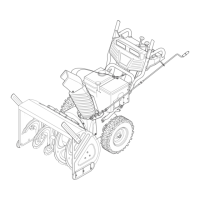
